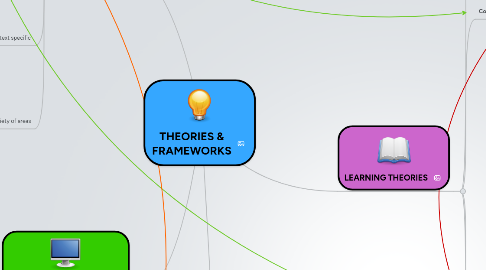
1. TECHNOLOGY THEORIES
1.1. Media Ecology
1.1.1. Study of media as environments
1.1.1.1. "...technology and techniques, modes of information and codes of communication play a leading role in human affairs."
1.1.1.2. Looking at their structure, content, and impact on people (how they behave and act)
1.1.2. Technology influences society
1.1.3. The medium is the message
1.1.4. Hot (low involvement) and cool (high involvement) media
1.1.5. Looks at how human's interaction with media facilitates or impedes our chances of survival
1.2. SCOT
1.2.1. Social Construction of Technology
1.2.2. Response to technological determinism (Media Ecology)
1.2.3. Society and human action influences and shapes technology
1.2.3.1. Multiple ways of constructing technologies
1.2.3.2. Focuses on the needs, interests, problems, and solutions of humans
1.2.4. Considering and understanding how technology is embedded in a social context
1.2.5. Methodology as well as a theory
1.2.5.1. Steps and principles to follow when analyzing the causes of technological success or failure
1.2.5.1.1. Success/failure of a particular piece of technology is socially determined
1.2.6. Explains how technologies arise, but ignores the consequences of technologies
2. TPACK
2.1. Technological Pedagogical and Content Knowledge
2.2. Teachers need three kinds of knowledge
2.2.1. Content
2.2.1.1. Knowledge about the subject area
2.2.2. Pedagogical
2.2.2.1. Knowledge about how to teach
2.2.3. Technological
2.2.3.1. Knowledge of the different types of technology tools that can be integrated into teaching and how to use them
2.3. TPACK is the intersection of all three types of knowledge and how they work together in a complicated way to support good teaching
2.4. The three domains of knowledge interact with each other to create sub domains
2.4.1. PCK - Pedagogical Content Knowledge: Knowledge about the interplay between how to teach and a specific subject area
2.4.2. TCK - Technological Content Knowledge: Knowledge of how technology can be used to teach or conceptualize content in new ways
2.4.3. TPK - Technological Pedagogical Knowledge: Use of technology to support different teaching approaches
2.5. Link to TPACK image
2.6. Supports technological intergration
2.6.1. Gives educators a framework b which to conceptualize the role of technology in teaching and learning
2.7. Context specific
2.7.1. TPACK will look different in an Elementary School compared to post-secondary education or the corporate sector
2.7.2. Dynamic and varies from teacher to teacher
2.7.3. Teachers can only do what they have the power to do
2.7.3.1. Resources
2.7.3.2. Training
2.7.3.3. Internet access
2.8. Can be applied in a variety of areas
2.8.1. Teacher professional development
2.8.2. Teacher education
2.8.3. Lesson plan evaluation
3. PHILOSOPHY OF TEACHNOLOGY
3.1. Similar to a Philosophy of Teaching but incorporates technology use in the classroom
3.1.1. How technology can and should be used when it comes to teaching
3.2. TPACK should inform one's philosophy of technology
3.2.1. Values and ideas around technology
3.3. Teachers often construct a written philosophy of their technology
3.4. Can include a variety of technological tools
3.4.1. Technology used in class
3.4.2. Learning Management Systems and Environments
3.4.3. Professional learning network
4. LEARNING THEORIES
4.1. Behaviourism
4.1.1. Learning from stimulus and response (repetition)
4.1.2. Operant conditioning (reinforcement)
4.1.3. Rewards, Punishments, and consequences
4.1.3.1. Learning does not require rewards or punishments
4.1.4. Drill and practice
4.1.4.1. "Practice makes perfect!"
4.1.5. Teacher-directed through mainly lecturing
4.1.6. Oversimplifies learning
4.1.6.1. The mind is not a blank slate
4.1.7. Focused on observable beahviour
4.1.7.1. Learning is not always tied to behaviours
4.2. Cognitivism
4.2.1. Response to Behaviourism
4.2.1.1. Going beyond the "blank slate"
4.2.2. Memory systems are active, structured, organized, processors of information
4.2.2.1. The mind as a computer
4.2.2.1.1. Network/Database/Mind Map
4.2.3. Connecting to prior knowledge and experiences
4.2.3.1. Schema/Scaffolding
4.2.4. Working memory has replaced short term memory
4.2.4.1. Encoding, storage, and retrieval
4.2.5. Focused on knowledge - difficult to measure higher order thinking skills
4.2.6. Remembering ways of thinming (rules, patterns, and strategies)
4.2.7. Cognitive Load Theory
4.2.7.1. Information processing theory used to explain the limits of working memory
4.2.7.2. How things look and are organized matters
4.2.7.2.1. Ease of user interface, general aesthetic, layout of information
4.2.7.3. "If nothing has been altered in long-term memory nothing has been learned."
4.2.7.4. Knowledge Compression: Chunking
4.2.7.4.1. Working memory operates more efficiently when info is presented in meaningful chunks
4.2.7.5. Ongoing repetition
4.2.7.5.1. Complex tasks require constant rehearsal in order for the working memory to process and for automation to develop
4.2.7.6. Three types
4.2.7.6.1. Extraneous CL - imposed by the manner in which info is presented to learners
4.2.7.6.2. Intrinsic CL - imposed by the learning task
4.2.7.6.3. Germane CL - devoted to processing information, constructing and automating schemas
4.3. Constructivism
4.3.1. The mind is a network
4.3.1.1. Using existing knowledge to build new knowledge
4.3.2. Learning is about building connections by actively interacting with the environment
4.3.2.1. Collaborative learning and engagement
4.3.2.2. Knowledge is actively constructed by learners
4.3.3. Basic skills are taught while solving complex problems
4.3.3.1. Problem-based learning and authentic tasks
4.3.3.2. Learning is most effective when learners create tangible, real-world objects
4.3.3.2.1. e.g. Lego robotics
4.3.4. Learning involves constructing one's own knowledge from one's own experiences (prior knowledge remixed to current context)
4.3.4.1. Active and discovery learning
4.3.4.1.1. Meaning created by each learner
4.3.5. Teacher as facilitator vs. director
4.3.6. Time consuming and difficult to assess
4.3.7. Knowledge is actively constructed by learners
4.3.8. Vygotsky's Zone of Proximal Development
4.3.8.1. Learning advances through stages as it is built upon previous learning
4.4. Connectivism
4.4.1. People learn when they can connect to specialized nodes of information sources
4.4.1.1. Knowledge exists among networks and people
4.4.1.2. Sharing of information and opinions
4.4.2. Accessing and interpreting accurate and up to date knowledge
4.4.2.1. e.g. Search engines
4.4.3. Maintaining connections is necessary to facilitate ongoing learning
4.4.3.1. e.g. Social networking
4.4.4. Capacity to know more is more critical than what is currently known
4.4.5. Ability to see connections between fields, ideas, and concepts is a important skill
4.4.6. Technologically enhanced
